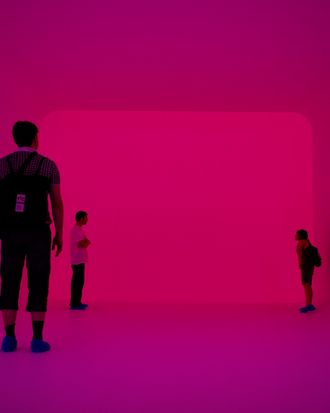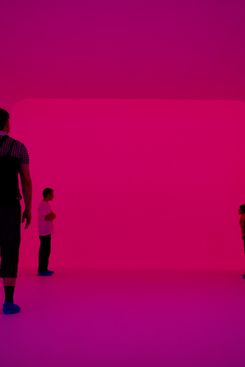Last week, elite artists mingled with fanny-packed tourists in the streets of Venice as, one by one, each of the pavilions of the 54th Biennale opened their doors amid grappa-soaked revelry. In addition to the nation-specific showcases, Christian Marclay let everyone have another rendezvous with The Clock; the Starn brothers did their Big Bamb├║ thing on top of a building next to the Peggy Guggenheim Collection; Giuseppe Stampone installed the phrase BYE BYE AI WEIWEI on a north-facing building on the shore of Giudecca, visible to all passing vaporetti; and we even got to sample a selection of snacks sprayed with silvery-blue paint at one of the openings. YouÔÇÖve read Jerry SaltzÔÇÖs best and worst picks from the festival, now get another take on the fifteen most titillating things uncovered in town.
Ganzfield APANIFrom group exhibition: ÔÇ£ILLUMInazioniÔÇØ at the ArsenaleA long line formed around the parapavilion housing TurrellÔÇÖs hyped-up, immersive light installation, an elevated white tunnel with a gently upward-sloping ramp illuminated by a shifting sequence of blue and pink lights. Viewers swap their dirty shoes for bright blue shower capsÔÇögreat color choice!ÔÇöso they donÔÇÖt muddy up the installationÔÇÖs pristine interior. As well, visitors are admonished at every turn not to walk to the end of the ramp. What was at the end of the ramp? Oblivion? We never found out; when we tried to sneak a peek over the edge, we were given some pretty serious stinkeye. (Apparently, someone had recently fallen in.)
Latin American Pavilion (Honduras)La Fisiolog├¡a del Gusto, 2010This stainless-steel tray heaped with the carious teeth of impoverished people from the artistÔÇÖs home country was devastating, and also weirdly intriguingÔÇöyou donÔÇÖt really have many opportunities to get up close and personal with the nooks and crannies of severely rotting molars. In fact, one small German child was so taken with it that he couldnÔÇÖt resist plunging his hand into the pile, letting out a rapturous squeal before being whisked away by his father.
Detail from UntitledFrom group exhibition: ÔÇ£ILLUMInazioniÔÇØ at the ArsenaleFischerÔÇÖs trio of wax sculptures included a giant rendering of the Rape of the Sabine Women; a pretty nifty office chair; and a life-size representation of FischerÔÇÖs pal Rudolf Stingel in the process of admiring the reproduction of GiambolognaÔÇÖs own rendering of the Sabine women. But unlike the stuff at Madame TussaudÔÇÖs, these waxworks have candle wicks in them, and are meant to be lit. We checked in on the three pieces a few times over the course of our visit, and found that we really dug this surreal fire-brain stage.
Indian PavilionElevator from the SubcontinentFrom group exhibition: ÔÇ£Everyone Agrees: ItÔÇÖs About to ExplodeÔÇØScariaÔÇÖs three-screen video installation, which mimics an elevator ascending through a series of mysterious rooms before rising above the building and hovering over the city for a few tense moments, really imparts the sensation of vertical motionÔÇöeven though the enclosure is completely stationary, and itÔÇÖs only the images that are scrolling. Brace yourself when it reaches the top; the simulated drop is pretty nausea-inducing, and itÔÇÖs a long way down.
Latin American Pavilion (Guatemala)Falso Le├│n, 2011Sculpture, cast bronze and Guatemalan goldAt the 2005 Biennale, Galindo won the Golden Lion for her controversial video Himenoplastia, which depicted the surgical reconstruction of her hymen. In 2011, desperate and broke, she sold her prize to artist Santiago Serra to be maintained. A replica of the lonely leonine figurine, sculpted by ├üngel and Fernando Poy├│n, now sits in a glass box in the city it came fromÔÇöa sly commentary on colonial-era looting, an expression of the artistÔÇÖs shame and abdication of dignity, and an examination of the physical objectÔÇÖs shifting value. A nice meta-example of giving the finger to the art world and its volatile economy.
The National Apavilion of Then and NowFrom group exhibition: ÔÇ£ILLUMInazioniÔÇØ at the ArsenaleWe couldnÔÇÖt seem to tear ourselves away from the British sculptorÔÇÖs otherworldly sound sculpture, which comprises a ramp leading into a harrowing little chamber lined with spiky black sound insulators. The first thing you notice is a ring of lights hanging from the ceilingÔÇöthe sort of thing you imagine youÔÇÖd see right before being abductedÔÇöbut then a sustained, high-pitched tone starts emerging from the floor, rising in volume to an uncomfortable intensity before suddenly disappearing, along with the light, leaving visitors submerged in darkness and eerie silence.
Japan PavilionTABAIMO: teleco-soupCrowds were spellbound by the young artistÔÇÖs immersive, phantasmagorical hand-drawn animated video installation, a whirlwind of twisted motifs from Japanese culture projected against mirrored panels and sloping surfaces.
Swiss PavilionDetail from Crystal of ResistanceHirschhornÔÇÖs known for his explosive, chaotic installations, and this oneÔÇÖs no exception: ItÔÇÖs a cesspool of television screens impaled with rough chunks of glass, repurposed Barbies and car seats, taxidermied woodland creatures, French gossip magazines, broken mirrors, reflective silver wallpapering, multi-colored bottle shards, crushed beer cans, gruesome images of facial disfigurement and violence, chairs covered in broken cell phones, and so on. But it was these vile, lamprey-like infested-wound-vagina-dentata packing-tape gashes in the wall sprouting clusters of polypoid Q-tips that really sent us over the edge.
United States PavilionTrack and FieldFrom: ÔÇ£GloriaÔÇØWe first saw this one from a distance, and we knew right away that Allora & Calzadilla were at it again. A crowd collected to gawk at and admire this robust young athlete jogging away insouciantly atop this overturned military tank. DonÔÇÖt worry, sheÔÇÖs not actually keeping pace with the tank tracks; thatÔÇÖs a functional treadmill sheÔÇÖs running on.
Canadian PavilionPoem for Venice, 2011 architectural facadeFrom ÔÇ£Steven Shearer: Exhume to ConsumeÔÇØShearerÔÇÖs poetry has the rhythm and syntax of a profane and pretentious magnetic-fridge-poetry setÔÇösample words include ÔÇ£necromasturbationÔÇØ and ÔÇ£witchbutcherÔÇØÔÇöbut we must admit, thereÔÇÖs something about the phrase ÔÇ£YOUR VOMIT OF HEAVENÔÇØ that really does it for us.
From group exhibition: ÔÇ£ILLUMInazioniÔÇØ at the ArsenaleIimpundulu Zonke Ziyandilandela (All the Lightning Birds Are After Me)We were spellbound by the South African artistÔÇÖs massive, fantastical rainbird-dragon made of rubber, ribbons, and various found objectsÔÇöthe noble beast occupies a plum spot deep in the belly of the Arsenale, its distinctive shadow and fiery wingspan adding flourish to the cavernous space.
French PavilionThe Wheel of FortuneFrom ÔÇ£ChanceÔÇØ BoltanskiÔÇÖs latest large-scale kinetic wonder, which comprises giant film strips of squash-faced newborns whirring through elaborate machinery that fills an entire room, feels like a sort of old-timey newspaper printing press loaded with social commentary. Every so often a bell rings, freezing the machinery so that one babyÔÇÖs face is projected on the wall. Does this have something to do with life and probability? The commodification of childbirth? The manufacturing of the human race?
United States PavilionAlgorithmFrom GloriaEveryone stood staring in silence at the ATM housed in this towering pipe organ, all silently wondering the same thing  does it work? But no one wanted to be the chump who gave it a whirl until one guy decided to take one for the team. The machine indeed gives out money (it would be ridiculous if it didnt), but it also releases a heavenly tone every time a user inserts a card or uses the touchscreen. Then it explodes into total reverie when it finally spits out your bills.
From group exhibition: ÔÇ£ILLUMInazioniÔÇØ at Palazzo delle Esposizioni, Giardini#Jan25 (#Sidibouzid, #Feb12, #Feb14, #Feb17)Just days before this photo was taken, JeaneÔÇÖs contribution to the Palazzo delle Esposizioni had been a giant, solitary cube comprising thousands of immaculately layered slabs of plasticine clay in red, black and whiteÔÇöcolors of various flags from the Arab-speaking world. While itÔÇÖs possible that the heavy politics of the piece, as well as its Twitter hashtag-referencing title, were a bit inaccessible, hundreds of visitors nevertheless delighted in being allowed to go crazy with the materials, using it to sculpt rudimentary phalluses, chalk their names on the walls, make fun of the Pope, build ramps and turrets on the floor, and promote themselves by using the clay to post their business cards to the wall (weÔÇÖre talking about you, Andrea Santoni from the International Trade Centre).
Austria PavilionOrient, 2011For the installation surrounding his exquisitely filmed, 9-minute video work Orient, the artist suspended thick white walls from the ceiling of the Josef Hoffman-designed pavilion, obscuring visitorsÔÇÖ bodies while leaving their legs and feet visible; altered six or so small Victorian oil paintings, such as a portrait of a woman whose head Schinwald completely swathed in white clothÔÇöuneasy, disturbing images that have the power ÔÇ£to make you quiet,ÔÇØ as one visitor put itÔÇöthen set them up in a labyrinth that led to two chambers in the back where the video (shown here) was being screened.


















